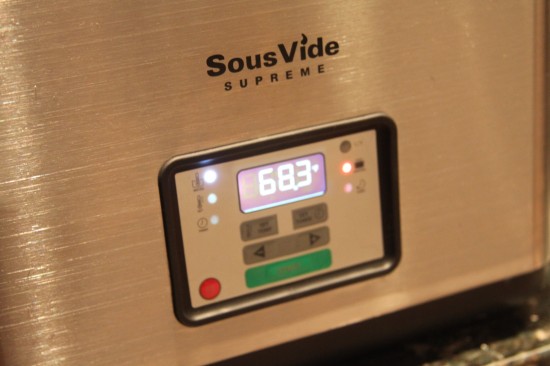
Sometime late last year, as I was following the Twitter feed for Tim Ferris, he mentioned a post where he listed “13 X-Mas Gifts That Can Change (or Save) Your Life.” In that post, he mentioned something called a “SousVide Supreme,” (SVS) which he said cooked “the single best chicken and steak of my life.” For someone who’s traveled the world as much as Mr. Ferriss, that was quite a claim. And yet, I had never heard of this thing … but I had to find out.
As it turns out, cooking via “sous-vide” — or “under vacuum” — isn’t all that new. In fact, a few popular cooking shows feature sous-vide cooking on a regular basis, including Bravo’s Top Chef. There’s only one company that makes the SousVide Supreme unit, but the method of cooking sous-vide can be done by anyone with a little know-how and patience. The SVS, however, takes all that needed patience and know-how and takes care of everything for you. OK, maybe not the patience part, but we’ll get to that.
Sous-vide cooking is a rather simple process, and the end result is so obvious that you’ve got to wonder why you hadn’t thought of it before. Essentially all you’re doing is taking some meat (or even vegetables), sealing it in a food-safe plastic bag, vacuuming all the air out from the bag, and submersing it in water that is the temperature of what you want your food to be at when you eat it. Cooking the food this way does two things that make sous-vide cooking stand out:
1. The food is cooked up to the temperature of the surrounding water and does not go any higher. This means you simply can’t overcook the meat. It’s obviously possible to undercook the food, but by following a basic guide, you can easily avoid that. If you set the water temperature to, say, 130-degrees F or so, you’ll get meat that’s 130-degrees, or medium-rare (if you call 130 medium-rare, which seems to be the popular case). In some cases you can leave the meat in the SVS for 48 hours and it will still not be overcooked (but there’s a gotcha to that, which I’ll explain later).
2. The meats stay in their juices. Since it’s tightly sealed in a bag, all of those natural juices of the meat stay within and around the meat. The end result is never dried out and is exceptionally succulent.
The trick to sous-vide cooking is of course making sure the water surrounding the food stays absolutely constant. Anyone with that previously-noted know-how and patience might be able to do this on a stove with a pot and thermometer, but when you’re trying to cook a leg of lamb in this thing, you’ll go bonkers. That’s where the SousVide Supreme unit comes in, as it perfectly retains that temperature for you … and that’s all it does, really; there’s no other magic necessary.
So, since the SVS is basically just a very easy way to go about cooking a-la sous-vide, this series of reviews is going to center mostly on the sous-vide method of cooking and how it compares to cooking via other methods. Ultimately, the decision to purchase the pricey SousVide Supreme comes down to your budget, patience and desire to cook via this method on a regular basis.